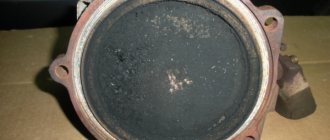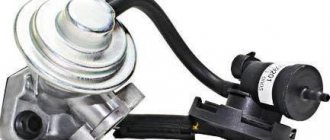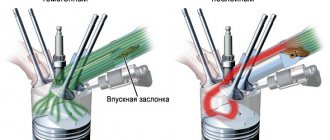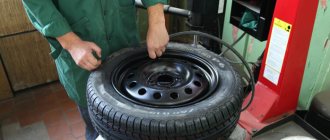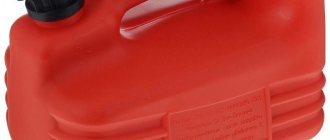The importance of knowing the year of your tires
Tires are a product obtained by mixing rubber, soot and sulfur, followed by heating the mixture to 150–160 degrees and molding. The physicochemical characteristics of the resulting product determine the technical parameters. Rubber for protectors must have high strength, wear resistance, and resistance to precipitation and sunlight.
The car owner should know the tire production date when:
- replacing used wheels. The minimum period of use is 5 years. Tires must be replaced after 5–7 years, depending on frequency of use, driving style and road quality;
- buying tires in a store. When choosing, you should look at color, uniformity of structure, elasticity, absence of cracks and tears. Black color, characteristic smell, elasticity indicate the quality of the product. It is important to observe temperature and humidity storage conditions in a cool, dry warehouse without exposure to sunlight. Then the performance characteristics remain unchanged for several years from the date of production.
Important! The year of manufacture and duration of use of a tire determine the safety and comfort of driving.
The date of manufacture is the reference point when purchasing tires in a store or purchasing used tires. With this information, you can protect yourself from buying old tires that won’t last long. Improper storage is indicated by the presence of cracks and loss of geometric shape. Moisture penetrates through cracks deep into the rubber frame, which leads to deformation of the inner invisible part of the tire.
Determining the release date
Regulations of the International Transport Organization oblige manufacturers to mark the production date of products on products. This data is written on the side of the tire and is separated from other markings. Since 2000, they consist of four digits located inside an oval stamp: the first two indicate the year-to-date production week number, the last two indicate the year of production. For example, marking 3119 indicates 31 weeks, which corresponds to August 2020.
Before 2000, the production date could be determined by three numbers: the first two indicated the week, the last one indicated the year. Manufacturers limited the life of rubber to 10 years. For example, the number 139 represents the 13th week of 1989 or 1999. The presence of a triangle after the numbers indicates the 90s.
In practice, in order to find out the year of manufacture of tires, you need to look at the side surface and find a combination of four numbers. To quickly determine, you can use online calculators on automobile websites. To do this, you need to enter 4 numbers in a special window. The calculator will display the date in terms of month and year.
Winter or just all-season?
Tire seasonality is the next most important designation. Tires, as you know, are summer, winter and sometimes all-season. Winter tires can be identified by a pictogram in the form of a snowflake against a background of three peaks (an international symbol with its own code 3PMSF). But getting the right to apply this designation is not so easy. That's why many tires have snowflakes on them, but as decoration. The same applies to the designation M+S (Mud + Snow, that is, dirt and snow). True, summer tires for SUVs also have the same marking, but in this case this only means that the tire is intended for off-road use. Studded winter tires have the word Studded on them, studless ones have the word Studless. If there is an inscription Studdable on the sidewall, then these are studded tires, that is, with holes for installing studs.
Winter studded tires have this marking or something similar.
Summer tires either do not have special markings or have symbols indicating that the tire performs well on wet surfaces - a painted umbrella or words such as Aquatred, Aquacontact, Rain, Water and Aqua. The M/T (Mud and Terrain) designation used for off-road tires is not a certified symbol. This designation of mud tires is present only in the model name.
This inscription indicates that the tire can be studded.
Tire life
Service life is the time during which the manufacturer provides a guarantee and is responsible for the occurrence of defects. There is a standard of 5 years, which corresponds to the minimum period of use. Tire manufacturers are constantly conducting research, improving technology, adding additives that slow down aging, which leads to an increase in service life.
Aging is caused by ozone in the air. It penetrates the pores of rubber and breaks down the bonds between rubber and sulfur compounds. This causes the rubber to lose elasticity and become hard. Loss of performance depends on the following factors:
- type of vehicle, its carrying capacity. It determines the standard tire mileage. For passenger cars with a carrying capacity of up to 2 tons, the mileage is 45,000 km, for trucks up to 4 tons - 60,000 km, over 4 tons - 70,000 km. After reaching these indicators, the tires should be carefully checked and replaced if necessary;
- manufacturer's brand. Purchasing tires from recognized manufacturers that guarantee quality will allow you to drive for 6–8 years;
- profile height. Tires with a low profile wear out faster;
- driving style. A sharp start or braking leads to greater tread wear compared to a smooth control mode;
- terms of Use. High temperature and high humidity accelerate aging;
- frequency of use of the vehicle;
- type and condition of the roadway. Asphalt concrete pavement will make it possible to operate tires for a longer period compared to crushed stone or dirt roads;
- storage conditions. You should follow the recommendations for proper storage provided by the manufacturer.
Important! Careful use of your vehicle can extend the life of your tires to 7–10 years.
Left or right?
Nowadays, more and more tires have a directional tread pattern, this trend extends to both summer and winter tires. The tire will only work correctly if it rotates in the right direction, otherwise the grip will deteriorate radically. However, initially all such tires are the same, but it is important to separate the wheels and rims into right and left ones. To do this, there is an arrow on the sidewall showing the direction of rotation, often with the inscription Rotation.
The arrow labeled Rotation shows in which direction the tires should rotate.
It is also necessary to monitor the direction of rotation if the tires are asymmetrical. They have the inscriptions Inside and Outside, that is, the inside and outside, so after mounting on the disks they also become left and right. We often see cars on the roads with tires mounted backwards, and believe me, you should stay away from them.
If the tires are installed correctly, you should not see this. This side of the tire should be internal, that is, hidden from view.
Adviсe
Practical observations allow us to give some advice to drivers:
- It is not recommended to use tires older than 10 years;
- after 5 years, tires must undergo annual diagnostics to detect premature wear;
- when changing wheels seasonally, it is recommended to store them in plastic bags that prevent sunlight and contact with air, in a vertical position;
- check tire pressure. Deviation of pressure from standard values can lead to overheating and early aging of rubber;
- monitor the appearance of damage and cracks;
- When purchasing new wheels, look for the closest date of manufacture;
- periodic balancing of wheel pairs. It can be combined with seasonal tire replacement. If the balance is imbalanced, the rubber wears out faster, vibration appears, which has a negative impact on the operation of the vehicle's running systems;
- it is necessary to replace tires when the color changes from black to gray, a whitish coating or cracks appear;
- You shouldn’t wait until the tread is completely worn out. It’s better to replace it before the maximum permissible mileage of 45,000 km expires. This will improve driving safety.
Any component of the car requires replacement or repair after a certain time. Car tires are subject to wear and tear under the influence of climatic factors, due to constant interaction with various types of road surfaces. To ensure reliable operation of the vehicle, it is necessary to periodically check the condition of the tires and replace them. When purchasing new tires, you should also pay attention to the date of manufacture. Proper storage for 3–5 years does not impair the performance properties of rubber.
Dots and stripes
So we get to the myths and legends in the field of tires. Surely each of you has at least once heard tales about how manufacturers designate tires of first, second or highest grade. They say that by the color of a dot on the sidewall or a stripe on the tread, you can distinguish defective tires from perfectly balanced ones. Alas, the reality is not so dramatic. The yellow dot or triangle on the sidewall indicates the lightest and softest part of the tire, and the red dot or triangle the heaviest.
The stripes on the tread itself are just stripes that are there to make the tires easier to store and pick up from the warehouse. This allows workers to ship tires based solely on the color of the stripes, rather than looking at the markings on the sidewall of each tire. Of course, color does not carry any meaning.
Why is this necessary? For minimal wheel balancing, the nipple must be aligned with the yellow marking or placed opposite the red one. But you need to mount the tire on the rim from the yellow marking area - in this place it will be easiest to pull the tire onto the rim, since here it is most pliable).
Paint is applied to tires before the tire has tread, that is, at the stage when it is still impossible to track defects.
